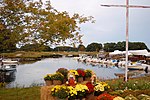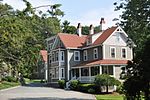North Shore (Massachusetts)

The North Shore is a region in the U.S. state of Massachusetts, loosely defined as the sea coast between Boston and New Hampshire. Its counterpart is the South Shore region extending south and east of Boston. The North Shore is a significant historical, cultural, and economic region of Massachusetts. The southern North Shore includes historic towns that are now part of the Boston metropolis. The Salem witch trials took place here. At the northern end, the Merrimack Valley was an important center of the Industrial Revolution in the United States. The North Shore includes a number of places that are significant in the literary and cultural history of the United States. The North Shore landscape includes seaports, fishing villages, and rocky coastline dotted with marshes and wetlands, as well as beaches and natural harbors. Cape Ann is the largest promontory.
Excerpt from the Wikipedia article North Shore (Massachusetts) (License: CC BY-SA 3.0, Authors, Images).North Shore (Massachusetts)
TR Maple Swamp Connector,
Geographical coordinates (GPS) Address Nearby Places Show on map
Geographical coordinates (GPS)
| Latitude | Longitude |
|---|---|
| N 42.6 ° | E -70.8 ° |
Address
TR Maple Swamp Connector
TR Maple Swamp Connector
01929
Massachusetts, United States
Open on Google Maps






